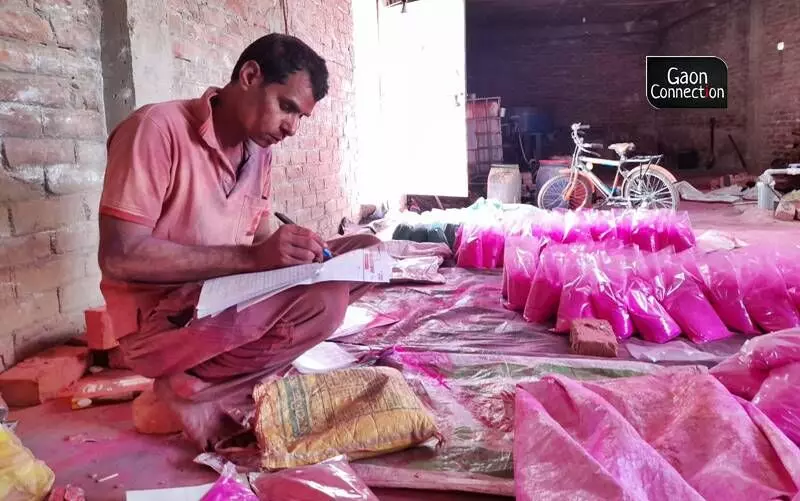Back to village after lockdown, he found a colourful opportunity to become self-reliant and provide livelihoods
Having returned to his village in the aftermath of the lockdown which was imposed to contain the outbreak of COVID-19 during the first wave of the pandemic in India, Mukesh Kumar decided to set up a small workshop to produce colours used in the Holi festival. Two years down the line, he owns his small business which also provides employment to almost a dozen of workers.
 Sumit Yadav 17 March 2022 12:29 PM GMT
Sumit Yadav 17 March 2022 12:29 PM GMT

The 35-year-old owner of a small workshop which manufactures gulaal did a few odd jobs before settling for his job as a driver which he pursued for the next 15 years in Mumbai. All photos by Sumit Yadav
Jagjeevanpur (Unnao)
With heaps of blue, red, yellow and green gulaal (a coloured powder used in Holi) scattered around him, Mukesh Kumar said that providing livelihoods to villagers who otherwise would have earned far less as agricultural labourers is a feeling that provides him the mental strength needed to run his enterprise.
"Kabhi hum doosre pe nirbhar the apna pate paalne ke liye, aaj hum khud doosron ko rozgaar de rahe, achha mehsoos hota hai ye soch ke," Mukesh Kumar, a resident of Unnao district's Jagjeevanpur village in Uttar Pradesh told Gaon Connection. [Earlier, I was dependent on others for my livelihood. Today, I am providing livelihood to others, it feels really good]
Following his father's death, less than a hectare of land was divided amongst three brothers including Kumar himself. The land he inherited from his father was less than a quarter of hectare — a holding which was not suitable for cultivation. This prompted Kumar to migrate to Mumbai in search of a livelihood at the age of 17.
The 35-year-old owner of a small workshop which manufactures gulaal did a few odd jobs before settling for his job as a driver which he pursued for the next 15 years.
The return to village and the beginning of a new journey
"Corona lockdown hit me hard. My livelihood was gone. I had no option but to return. It was a maddening sight, I remember. People were desperately wanting to get back home like a flock of terrorised sheeps. All this was too much for me to bear… My yearning to get back home boiled over while I was returning home from Mumbai and decided to stay back," Kumar told Gaon Connection.
But merely a return to home wasn't enough as the need to have a source of income loomed large.
"I did some talking with my friends and acquaintances and arrived at a conclusion that gulaal making was a business not practised by many in the area. I thought it can provide a better income as compared to conventional businesses like grocery shops and small restaurants where the risk of failing is much higher," he said.
But the beginning wasn't smooth for the 35-year-old as the COVID-19 pandemic didn't let his business grow for two consecutive years.
"It was hard to find the suppliers of the raw materials at first as every business in the area just seemed to have receded due to Corona. The demand for gulaal picks up in January and continues till Holi. Last year, I hardly earned less than a lakh rupees but this festive season has been better. I have sold almost fifty gunny bags of gulaal which weighed fifty kilogrammes each. I supply gulaal to retail sellers who buy it at a price of almost forty rupees per kilogramme," Kumar informed Gaon Connection.
"My sales have crossed a lakh rupees this year so far and it is not bad as the gulaal making lasts for three months in a year from January to March. For the rest of the year, I and my workers can also look for other sources of livelihood such as farming and dairy," he added.
Making of gulaal
When Gaon Connection visited Kumar's workshop, it was found that at least a dozen of workers were busy mixing, sieving and packaging gulaal.
When asked about the number of workers employed by him, Kumar said, "I usually employ ten workers but since its peak time for the gulaal sale, some more workers have also joined in. These workers are paid two hundred rupees for a day's labour,".
Kumar informed Gaon Connection that two types of raw materials are used in the making of gulaal — arrowroot flour and water colours.
"The ararot flour is available in the market and the water colours have to be brought from the neighbouring Kanpur district. We basically mix these two things and add chemical fragrance. Then the coloured powder is sieved to filter impurities and packed in small packets for selling them to the retail sellers," he said.
Kumar however complained that it is hard for him to expand his business as he needs financial investment which no bank is willing to loan.
"All these government schemes to support rural entrepreneurs seem to be only on paper. I visited banks to avail loans but the paperwork and the conditions are s stressful that I gave up the pursuit. I will be happy to provide livelihoods to far more people if somebody trusts my intention and provides an aid," Kumar said.
#Holi Special #Holi festival gulaal Covid-19
More Stories




